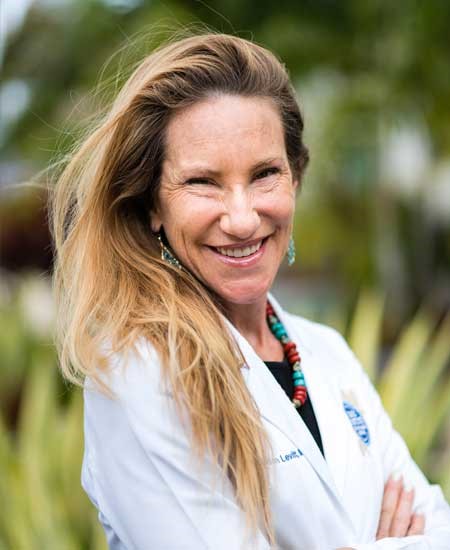
I don’t know about you, but two months of being stuck inside took its toll on my complexion. Between the lack of fresh air, too much stress, too little exercise and a less-than-healthy diet, the skin all over my body turned dull, dry and flaky.

Supermodel Miranda Kerr uses a body brush to improve skin and remove toxins.
But I knew we would all be back to normal soon… so I used this time to get my skin ready for summer.
I’d just finished reading a meditation blog that interviewed Miranda Kerr. Miranda is a great friend of the Sears Institute for Anti-Aging Medicine… and has met with Dr. Sears a number of times, so I was interested in what she was doing.
She mentioned she starts each day off with dry brushing — “religiously.”
That was a great reminder that I needed to get back into my healthy skincare routines.
If you’re not familiar with it, dry brushing not only improves how your skin looks — it improves your overall health. In fact, there are numerous benefits. Dry brushing:
- Eliminates dead skin through exfoliation. Exfoliation means clearing away the dry, dead skin cells that build up on the surface of your skin. It’s even more important as we age because the older we get, the slower our skin cells regenerate. They begin to build up making skin look dull, dry and wrinkled. It can also lead to blocked pores — and eventually blackheads and acne. Body brushing not only clears away these dead cells, it speeds up the formation of new ones. And new skin cells are softer, smoother and glowing.
- Reduces the appearance of cellulite. Cellulite is pockets of fat that pop through your collagen and connective tissue and pucker like an orange peel. Rebuilding collagen is the only way to permanently remove it. But dry brushing can minimize the appearance of this kind of fat. It works by increasing circulation which reduces inflammation and strengthens your connective tissue. This in turn reduces the appearance of cellulite. A study found that massaging connective tissue — similar to body brushing — helped thin out this subcutaneous fat in people with cellulite.1
- Removes toxins by stimulating your lymphatic system. Your lymphatic system is a large network of lymph nodes and vessels. It gathers waste from cells and toxins from the environment that accumulate in your body, clogging it up and making you sick. Fatigue, arthritis, headaches, digestive trouble, weight gain and sinus infections are signs of a clogged lymphatic system. So is dry and itchy skin. One-third of your body’s toxins are excreted through the skin. Regular dry brushing can help you remove lymphatic waste more efficiently.2
- Increase circulation for a youthful glow. Your circulation system delivers nutrients, hormones and oxygen to your skin. So when your circulation suffers, the appearance of your skin does as well. Poor blood flow leads to a dull, pallid complexion, dark spots and uneven skin tone, acne, varicose veins and even wrinkles. Dry brushing invigorates your skin to increase blood flow and circulation.
- Allows your skin to absorb more nutrients. Dead skin cells, environmental pollution and sweat can block the pores on your skin. And sometimes showering isn’t enough to clear these blockages. When this happens, your skin can’t absorb the nutrients it needs. I’m talking about the topical application of vitamins… Like vitamin C for elasticity, vitamin E to reduce inflammation, vitamin D to destroy the free radicals that cause premature aging and omega-3s to reduce signs of photoaging. Dry brushing will open up your pores allowing you to absorb these anti-aging nutrients.
Get Ready to Body Brush

Dry brushing exfoliates skin and releases body toxins.
You don’t need more than a brush to get started. I suggest brushing in the morning because it will give you a burst of energy. If you choose to dry brush at night, use softer and more gentle pressure.
Now you’re ready to start. Remember to always brush toward your heart.
- Stand in the shower or bathtub (to catch dead skin cells).
- Begin at your feet and move up your body in a long, sweeping motion.
- Brush several times, overlapping each area as you go.
- Use light pressure in areas where your skin is thin and harder pressure on thicker skin, like the soles of your feet.
- Brush your arms after you have brushed your feet, legs and mid-section. Brush upward toward your armpits as well as toward the center.
- Jump in the shower to wash away remaining dead skin cells. Use a gentle cleanser and skip the loofah.
- After your shower, dry off and moisturize your skin.
I recommend dry brushing at least once a week, but feel free to brush your body every day. But only brush your face once a week and use a gentler brush.
However, I do suggest using a gentle exfoliating facial scrub to clean your face every night. This will increase skin turnover. Look for a scrub that contains vitamins A and E, as well as omega-3 fatty acids.
In Gratitude,

Dr. Alison Levitt
P.S. Buying Guide: Don’t buy a brush with harsh bristles. It won’t do the job any more effectively — and it can actually damage and break your skin instead of helping it.
I suggest buying a natural bristle brush made from boar’s hair or a natural plant source like cactus fibers or jute. Synthetic bristles are just too hard on your skin.
A long-handled brush will help you get to hard-to-reach areas while a brush that fits in the palm of your hand gives you better control. I suggest looking for a brush that comes with removeable handles — that way you get the best of both worlds.

Dr. Alison Levitt brings more than 23 years of experience in regenerative medicine to the Sears Institute to give her patients total health and wellness – both inside and out.
She specializes in empowering patients to take back their health by maintaining their optimal health. Her patients get the most advanced regenerative medicine therapies to help reverse their health conditions.
References
1Tunay VB, et al. “Effects of mechanical massage, manual lymphatic drainage and connective tissue manipulation techniques on fat mass in women with cellulite.” J Eur Acad Dermatol Venerol. 2010;24(2):138-142.
2Skobe M and Detmar M. “Structure, function and molecular control of the skin lymphatic system.” J Investig Dermatol Symp Proc. 2000;5(1):14-19.
3Fournet M, et al. “Glycation damage: A possible hub for major pathophysiological disorders and aging.” Aging Dis. 2018;9(5):880-900.








